You can use any third party library like https://github.com/nicklockwood/FXBlurView
Create blurred image using this and add it to your cell on the specific event.
Or you can use following method from Apple:
// This method is taken from Apple's UIImageEffects category provided in WWDC 2013 sample code
- (UIImage *)applyBlurWithRadius:(CGFloat)blurRadius tintColor:(UIColor *)tintColor saturationDeltaFactor:(CGFloat)saturationDeltaFactor maskImage:(UIImage *)maskImage
{
// Check pre-conditions.
if (self.size.width < 1 || self.size.height < 1) {
NSLog (@"*** error: invalid size: (%.2f x %.2f). Both dimensions must be >= 1: %@", self.size.width, self.size.height, self);
return nil;
}
if (!self.CGImage) {
NSLog (@"*** error: image must be backed by a CGImage: %@", self);
return nil;
}
if (maskImage && !maskImage.CGImage) {
NSLog (@"*** error: maskImage must be backed by a CGImage: %@", maskImage);
return nil;
}
CGRect imageRect = { CGPointZero, self.size };
UIImage *effectImage = self;
BOOL hasBlur = blurRadius > __FLT_EPSILON__;
BOOL hasSaturationChange = fabs(saturationDeltaFactor - 1.) > __FLT_EPSILON__;
if (hasBlur || hasSaturationChange) {
UIGraphicsBeginImageContextWithOptions(self.size, NO, [[UIScreen mainScreen] scale]);
CGContextRef effectInContext = UIGraphicsGetCurrentContext();
CGContextScaleCTM(effectInContext, 1.0, -1.0);
CGContextTranslateCTM(effectInContext, 0, -self.size.height);
CGContextDrawImage(effectInContext, imageRect, self.CGImage);
vImage_Buffer effectInBuffer;
effectInBuffer.data = CGBitmapContextGetData(effectInContext);
effectInBuffer.width = CGBitmapContextGetWidth(effectInContext);
effectInBuffer.height = CGBitmapContextGetHeight(effectInContext);
effectInBuffer.rowBytes = CGBitmapContextGetBytesPerRow(effectInContext);
UIGraphicsBeginImageContextWithOptions(self.size, NO, [[UIScreen mainScreen] scale]);
CGContextRef effectOutContext = UIGraphicsGetCurrentContext();
vImage_Buffer effectOutBuffer;
effectOutBuffer.data = CGBitmapContextGetData(effectOutContext);
effectOutBuffer.width = CGBitmapContextGetWidth(effectOutContext);
effectOutBuffer.height = CGBitmapContextGetHeight(effectOutContext);
effectOutBuffer.rowBytes = CGBitmapContextGetBytesPerRow(effectOutContext);
if (hasBlur) {
// A description of how to compute the box kernel width from the Gaussian
// radius (aka standard deviation) appears in the SVG spec:
// http://www.w3.org/TR/SVG/filters.html#feGaussianBlurElement
//
// For larger values of 's' (s >= 2.0), an approximation can be used: Three
// successive box-blurs build a piece-wise quadratic convolution kernel, which
// approximates the Gaussian kernel to within roughly 3%.
//
// let d = floor(s * 3*sqrt(2*pi)/4 + 0.5)
//
// ... if d is odd, use three box-blurs of size 'd', centered on the output pixel.
//
CGFloat inputRadius = blurRadius * [[UIScreen mainScreen] scale];
NSUInteger radius = floor(inputRadius * 3. * sqrt(2 * M_PI) / 4 + 0.5);
if (radius % 2 != 1) {
radius += 1; // force radius to be odd so that the three box-blur methodology works.
}
vImageBoxConvolve_ARGB8888(&effectInBuffer, &effectOutBuffer, NULL, 0, 0, (uint32_t) radius, (uint32_t) radius, 0, kvImageEdgeExtend);
vImageBoxConvolve_ARGB8888(&effectOutBuffer, &effectInBuffer, NULL, 0, 0, (uint32_t) radius, (uint32_t) radius, 0, kvImageEdgeExtend);
vImageBoxConvolve_ARGB8888(&effectInBuffer, &effectOutBuffer, NULL, 0, 0, (uint32_t) radius, (uint32_t) radius, 0, kvImageEdgeExtend);
}
BOOL effectImageBuffersAreSwapped = NO;
if (hasSaturationChange) {
CGFloat s = saturationDeltaFactor;
CGFloat floatingPointSaturationMatrix[] = {
0.0722 + 0.9278 * s, 0.0722 - 0.0722 * s, 0.0722 - 0.0722 * s, 0,
0.7152 - 0.7152 * s, 0.7152 + 0.2848 * s, 0.7152 - 0.7152 * s, 0,
0.2126 - 0.2126 * s, 0.2126 - 0.2126 * s, 0.2126 + 0.7873 * s, 0,
0, 0, 0, 1,
};
const int32_t divisor = 256;
NSUInteger matrixSize = sizeof(floatingPointSaturationMatrix)/sizeof(floatingPointSaturationMatrix[0]);
int16_t saturationMatrix[matrixSize];
for (NSUInteger i = 0; i < matrixSize; ++i) {
saturationMatrix[i] = (int16_t)roundf(floatingPointSaturationMatrix[i] * divisor);
}
if (hasBlur) {
vImageMatrixMultiply_ARGB8888(&effectOutBuffer, &effectInBuffer, saturationMatrix, divisor, NULL, NULL, kvImageNoFlags);
effectImageBuffersAreSwapped = YES;
}
else {
vImageMatrixMultiply_ARGB8888(&effectInBuffer, &effectOutBuffer, saturationMatrix, divisor, NULL, NULL, kvImageNoFlags);
}
}
if (!effectImageBuffersAreSwapped)
effectImage = UIGraphicsGetImageFromCurrentImageContext();
UIGraphicsEndImageContext();
if (effectImageBuffersAreSwapped)
effectImage = UIGraphicsGetImageFromCurrentImageContext();
UIGraphicsEndImageContext();
}
// Set up output context.
UIGraphicsBeginImageContextWithOptions(self.size, NO, [[UIScreen mainScreen] scale]);
CGContextRef outputContext = UIGraphicsGetCurrentContext();
CGContextScaleCTM(outputContext, 1.0, -1.0);
CGContextTranslateCTM(outputContext, 0, -self.size.height);
// Draw base image.
CGContextDrawImage(outputContext, imageRect, self.CGImage);
// Draw effect image.
if (hasBlur) {
CGContextSaveGState(outputContext);
if (maskImage) {
CGContextClipToMask(outputContext, imageRect, maskImage.CGImage);
}
CGContextDrawImage(outputContext, imageRect, effectImage.CGImage);
CGContextRestoreGState(outputContext);
}
// Add in color tint.
if (tintColor) {
CGContextSaveGState(outputContext);
CGContextSetFillColorWithColor(outputContext, tintColor.CGColor);
CGContextFillRect(outputContext, imageRect);
CGContextRestoreGState(outputContext);
}
// Output image is ready.
UIImage *outputImage = UIGraphicsGetImageFromCurrentImageContext();
UIGraphicsEndImageContext();
return outputImage;
}
//Usage:
[imageToBlur applyBlurWithRadius:2.0f tintColor:[UIColor clearColor] saturationDeltaFactor:1.0 maskImage:nil];

